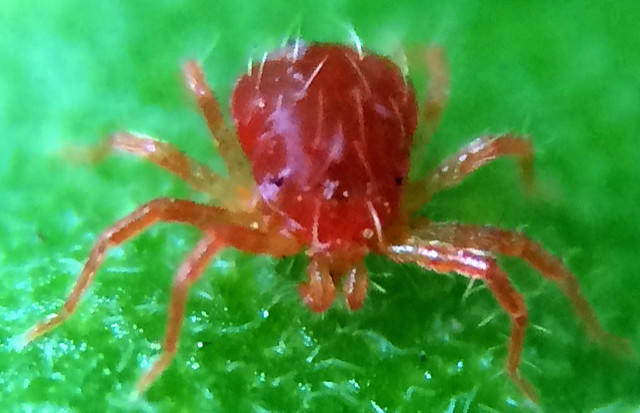Map Snapshot



3 Records
Relationships
"Predatory on other mites and small insects" (BugGuide).
Seasonality Snapshot
Source: Wikipedia
| Anystis Temporal range:
| |
|---|---|

| |
| Anystis baccarum | |
| Scientific classification | |
| Kingdom: | |
| Phylum: | |
| Class: | |
| Subclass: | |
| Order: | |
| Family: | |
| Genus: | Anystis von Heyden, 1826
|
Anystis (whirligig mites) is a genus of mites. They are predatory on other mites and small insects. Species in this genus are often red, long-legged, and range in size from 500μm – 1500μm.[1] Both the genus and the family Anystidae are referred to as whirligig mites.
Identification
[edit]Members of the genus have broad and short bodies (almost trapezoidal) with two pairs of eyes. They have a prodorsal shield – the large covering on the anterior of the body – which is indented posteriorly (kidney-shaped). Two pairs of eyes are located posteriorly and laterally to the prodorsal shield. From the shield arise two long pairs of hair-like setae and a pair of similarly shaped sensory organs (sensilla). Another pair of sensilla are found on the anterior portion of the mite's main body, the idiosoma. The chelicerae, specialized mouthparts, each have a pair of hook-shaped chela on the distal portion and a pair of setae as well. The tarsus, the last segment of the leg, ends in two claws (which may be (combed, toothed or pilose) and has a claw- or bell-like empodium (a structure between the claws).[1]
Agricultural use
[edit]The species Anystis baccarum has been used as a form of biological pest control in apple orchards[2] due to their predation of Panonychus ulmi, a mite species that causes massive economic loss in apple trees.[3] Though A. baccarum is the most well known and exemplary member of the genus, it is unknown if other species may be able to fill a similar role to it in terms of pest control.
Species
[edit]Species include:[4]
- Anystis agilis
- Anystis andrei
- Anystis baccarum[5]
- Anystis berlesi
- Anystis borussica
- Anystis coccinea
- Anystis cornigerum
- Anystis cursorium
- Anystis germanica
- Anystis pallescens
- Anystis pini
- Anystis rabuscula
- Anystis salicinus
- Anystis sellnicki
- Anystis triangularis
- Anystis vitis
- Anystis voigtsi
- Anystis wallacei[6]
References
[edit]- ^ a b Smith Meyer, M. K. P.; Ueckermann, E. A. (1987). "A taxonomic study of some Anystidae (Acari: Prostigmata)". Entomology Memoir. 68: 1–37.
- ^ Cuthbertson, Andrew G. S.; Qiu, Bao-Li; Murchie, Archie K. (2014-07-24). "Anystis baccarum: An Important Generalist Predatory Mite to be Considered in Apple Orchard Pest Management Strategies". Insects. 5 (3): 615–628. doi:10.3390/insects5030615. ISSN 2075-4450. PMC 4592577. PMID 26462829.
- ^ Mason, Peter G.; Huber, J. T. (2001). Biological Control Programmes in Canada, 1981-2000. CABI. p. 213. ISBN 1845933214.
- ^ Anystis. Fauna Europaea.
- ^ Filimonova SA (2008). "The fine structure of the midgut in the mite Anystis baccarum (L.) (Acari, Actinedida: Anystidae)". Arthropod Structure & Development. 37 (4): 299–309. doi:10.1016/j.asd.2007.11.005. PMID 18396461.
- ^ Otto, J.C. (1992). "A new species of Anystisvon heyden compared with Anystis Salicinus(Linnaeus) (Acarina: Anystidae)". International Journal of Acarology. 18: 25–35. doi:10.1080/01647959208683925.
External links
[edit] Data related to Anystis at Wikispecies
Data related to Anystis at Wikispecies- Bugguide.net. Genus Anystis - Whirligig Mites


